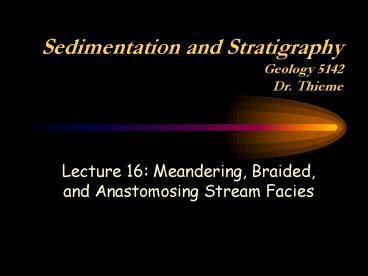Sedimentation and Stratigraphy Geology 5142 Dr' Thieme - PowerPoint PPT Presentation
1 / 30
Title:
Sedimentation and Stratigraphy Geology 5142 Dr' Thieme
Description:
Harrisburg (200-500 ft) Somerville ( 200 ft) Peneplains of Mid-Atlantic. Schooley. Harrisburg. Somerville. Objections to the Davis Cycle. no intact peneplains exist ... – PowerPoint PPT presentation
Number of Views:98
Avg rating:3.0/5.0
Title: Sedimentation and Stratigraphy Geology 5142 Dr' Thieme
1
Sedimentation and StratigraphyGeology 5142Dr.
Thieme
- Lecture 16 Meandering, Braided, and Anastomosing
Stream Facies
2
Fluvial Transport and Alluvial Sediment
- Fluvial - anything associated with rivers or
stream energy - Alluvial - water-laid sediment
- specific to the sediment in river valleys
- more general in that it also applies to
water-laid deposits in other settings - controlled by
- supply of detritus
- gradient of the river
- discharge magnitude and seasonal variations
3
Stream Longitudinal Profile
Gradient decreases along the downstream axis.
4
Hydraulic Geometry
- channel width, depth,
- and velocity all increase
- in the downstream
- direction
- Depth increases at
- the fastest rate
- Why does velocity increase?
5
- Mountain streams have
- turbulent flow
- Water molecules and
- sediment particles are moving
- at many angles which are not
- parallel to streamflow
- Boulders or large
- woody debris in a
- channel introduce more
- frictional drag
6
Turbulent and Laminar Flow
- Deep, narrow channel at upstream end.
- More of the water comes in contact with channel
walls. - Velocity is decreased by frictional drag.
- Wide, shallow channel at downstream end has
laminar flow. - Most of the resistance to flow comes from shear
between water planes.
7
(No Transcript)
8
(No Transcript)
9
Continuity Equation
- Similar to Principle of Conservation of Mass and
Energy in Physics
Q w d v
discharge width depth velocity
10
Base Level
A Peneplain in the Davis Cycle of Erosion
- the lowest elevation to which a stream can erode
its channel
11
Graded Stream
- has just the velocity required for the load
supplied from the drainage basin - Stream adjustments toward equilibrium or graded
condition - Raising base level causes deposition
- Lowering base level causes erosion
- Increasing gradient causes meandering
12
Sinuosity
- ratio of stream length (along the thalweg) to
valley length - sinuosity gt 1.5 implies meandering
- meandering of rivers dissipates stream power over
low relief surfaces
13
Types of river
- Straight - single, low sinuosity (lt 1.5) channel
without dividing bars - Meandering - high sinuosity (gt 1.5) channel
formed as one bank is eroded and its sediment
deposited downstream on the opposite bank - Anastomosing - a number of separate channels
which divide and join along the river - Braided - a number of separate channels, each
having low sinuosity, separated by bars that are
emergent when the river level is low
14
Braided channels become straight during floods
that submerge the longitudinal bars.
Anastomosing channels are more permanently
separated by islands built of river alluvium.
Maximum meander amplitude is a threshold above
which meanders become cutoff to form oxbow lakes.
15
(No Transcript)
16
(No Transcript)
17
(No Transcript)
18
- Meandering Stream
- predominantly transport sediment in suspension
- channel bedload is deposited at the base of each
point bar - cross-bedded and cross-laminated sands are
laterally accreted as the channel builds the
point bar - column fines upward
- suspended load predominates toward the top of the
river - "overbank" floods transport sediment into the
floodplain
19
(No Transcript)
20
(No Transcript)
21
Controlling Factors
- The following factors favor the type of river,
favoring the braided or anastomosing channel
patterns - steep slope (gt 1º)
- erodible banks
- abundant coarse sediment supply
- rapid fluctuations in discharge
22
(No Transcript)
23
- Braided Stream
- predominantly transport sediment as bedload
- gravel or coarse sandy basal lags of wide,
shallow channels - trough and planar cross-bedded sands will
alternate in distinct sets - crossbed set size and mean grain size decrease
upward - may have a thin "overbank" topstratum of
suspended sediment
24
- Braided Stream
- rivers fed by glacial meltwater provide some of
the most typical sections - both gravel lag and bedload sand beds
- ripple-bedded sands (Sr) represent small bars
- thinner beds of laminated fine sand or mud (Fi)
from slackwater between meltwater pulses
25
- Braided Stream
- rivers in arid to semiarid climates where coarse
clastic detritus is provided by - steep slope
- erodible bedrock
- planar crossbeds represent longitudinal bars that
give way to transverse ("linguoid") bars up
section
26
- Braided Stream
- gravel bed rivers
- debris flows or alluvial fans supplying detritus
along the channel margins - bar deposits show slightly greater sand fraction
or better sorting - little or now slackwater stage deposition
27
Youth - relief is steepest - V shaped
channels Mature - wider valleys -
streams meander Old Age gently rolling hills
- low gradient channel -
meandering or braided Peneplain -
flat, level plain at base
level Rejuvenation starts the cycle
over
28
Davis Cycle of Erosion
- stages are universal
- cycles were identified with erosion surfaces or
peneplains in New Jersey and Pennsylvania - Schooley (gt1000 ft)
- Harrisburg (200-500 ft)
- Somerville (lt200 ft)
29
Peneplains of Mid-Atlantic
- Schooley
- Harrisburg
- Somerville
30
Objections to the Davis Cycle
- no intact peneplains exist
- stream erosion rates vary with
- bedrock resistance
- climate
- tectonics probably has no regular cycle
- glacial/interglacial cycle affects erosion
- emphasis on time over process































